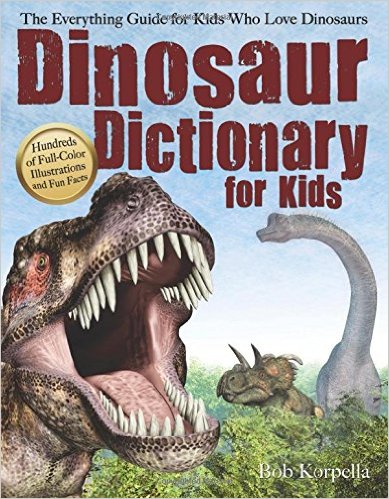Click here for the PDF version of this article
 Dinosaur Dictionary for Kids
Dinosaur Dictionary for Kids
Bob Korpella
Prufrock Press Inc., 2015
paperback, $13.95, 176 pp.
ISBN: 978-1-61821-513-0
Kids love dinosaurs!
Adults love dinosaurs!
And reviewers, especially, love dinosaurs!
Dinosaurs turn us all into little children. Just go to a museum and observe. Even the TV program “Blue Bloods” had the Commissioner guide his grandson’s class to the dinosaurs on a field trip.
The Dinosaur Dictionary for Kids by Bob Korpella is so beautifully illustrated that it did not surprise me when it turned out to be a Prufrock book. Prufrock knows how to illustrate its pages—clear to the edges.
Even though this is a dictionary, it is also a picture book. Before you look at the words, look at the illustrations. And because it is a dictionary which alphabetizes all those dinosaurs, you will read names you NEVER saw before—with matching illustrations so that your brain has the word AND the graphics simultaneously.
The Table of Contents is an education in itself:
Introduction to the Mesozoic Era
Introduction to the Jurassic Period
Introduction to the Cretaceous Period
Other Animals of the Mesozoic Era
Dinosaur Bites: Activities and More
Bibliography
About the Author
Index of Species
Not one of these pages lacks illustrations. Color explodes from each one. And that is only the table of contents! Each following page is full of color— from top to bottom.
Listen to the first paragraph from this gripping book!
“Picturing dinosaurs and the world in which they lived tickles the imagination. Creatures that disappeared from the planet 65 million years ago became vivid in our minds as we read and study them. But think about it—some of the biggest animals to have ever roamed the Earth may have walked across what is now your back yard. Their fossilized bones may rest beneath your own basement!”
And Bob Korpella’s note on using the dictionary is so helpful.
He tells us that each dinosaur’s entry lists
- its genus name;
- how to pronounce the name;
- how long it lived (mya, or million years ago);
- its estimated length in feet;
- its estimated weight in pounds;
- the country, state, or region where its fossils were discovered;
- its diet (carnivore, herbivore, omnivore);
- a description and facts about the dinosaur.
As if that isn’t enough help, the very next page is a list of Basic Terms of the Mesozoic Era. Even scientists (unless this is their field) don’t know all this. This pattern repeats itself for all the Eras.
My favorite is the page that tells us what a Taxonomy is. My brain was so happy to be young again, remembering when I had to memorize that.
I didn’t know that there were so many dinosaurs, but children adore memorizing all their names. In my teaching fantasy world, I would buy a book for each child. It would be my reading program and my science program. And at the end of the year, each child would take this book home to keep and use forever.
Short of that, just buy “Dinosaur Dictionary for Kids” for your own children, your grandchildren, and at least a few copies for your classroom.
 Elaine S. Wiener is Associate Editor for Book Reviews for the Gifted Education Communicator and can be reached at 17elaine@att.net.
Elaine S. Wiener is Associate Editor for Book Reviews for the Gifted Education Communicator and can be reached at 17elaine@att.net.